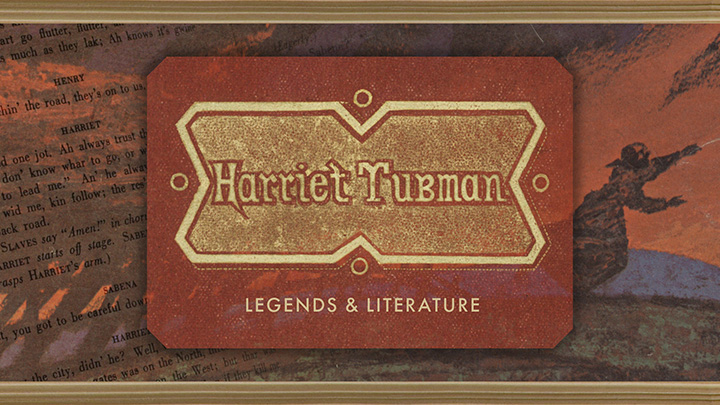
While Harriet Tubman’s exact date of birth is unknown, the most recent historical research places it in 1822. The 200th anniversary of the event is currently being celebrated throughout the country. This exhibition marks the occasion by showcasing Special Collections holdings of Harriet Tubman-related works—a very small sample of the countless works produced over the years in recognition of her life and achievements.
Born on Maryland’s Eastern Shore, Tubman lived her life in bondage until 1849, when she emancipated herself by escaping to Pennsylvania. She subsequently returned to the South multiple times to retrieve enslaved family and friends that she had left behind. It is this part of her life—her time as a conductor on the Underground Railroad, leading groups of enslaved people to northern states and to Canada—that has been recounted to successive generations of Americans and cemented her status as a national hero. However, Tubman’s exploits were not limited to escorting others to freedom. She helped John Brown plan and recruit participants for his 1859 raid on Harper’s Ferry. She gave talks about her life as an enslaved woman to encourage support for the abolitionist movement. During the Civil War, she performed domestic labor as a cook and a laundress for Union troops. In her additional duties as a nurse, her knowledge of herbs and plant-based remedies was incredibly helpful for treating sick soldiers. Some of the wounded she tended to included members of the 54th Massachusetts, one of the first Black units to fight in the Civil War. She also served as a scout and a spy, gathering information on Confederate territory and defenses. In 1863, she became the first woman in the Civil War to plan and supervise an armed military operation when she led the Combahee River Raid, which struck a major blow to Confederate forces by liberating hundreds of enslaved people and confiscating or destroying valuable supplies. After the war ended, Tubman settled in upstate New York, taking care of her parents and other members of her family—often as the sole wage-earner of the household. She was a suffragist—she maintained a strong relationship with Susan B. Anthony—and a dedicated community activist. In her final decades of life, she established a nursing home for Black elders in need. Tubman died on March 10, 1913, at slightly over 90 years of age.
Tubman herself never learned to read or write. As a result, all written accounts of her life and subsequent fictional portrayals have been shaped by how others perceived her or felt she should be remembered. Over the years, she has been gradually mythologized, with certain aspects of her story codified as key elements to be told again and again, sometimes to the point of exaggeration, while other aspects have been overlooked or excluded. Generations of writers have incorporated her into narratives of their own design—some embracing the mythology that has been built up around her, others pushing back against it. The items in this exhibition reflect the many ways in which writers have depicted the woman known as Harriet Tubman, whose historical significance is inextricable from her legendary status.
Credits
Exhibition curated by Shelby Daniels-Young, Pauline A. Young Resident, Special Collections. Graphic design elements by Jaynell Keely.


